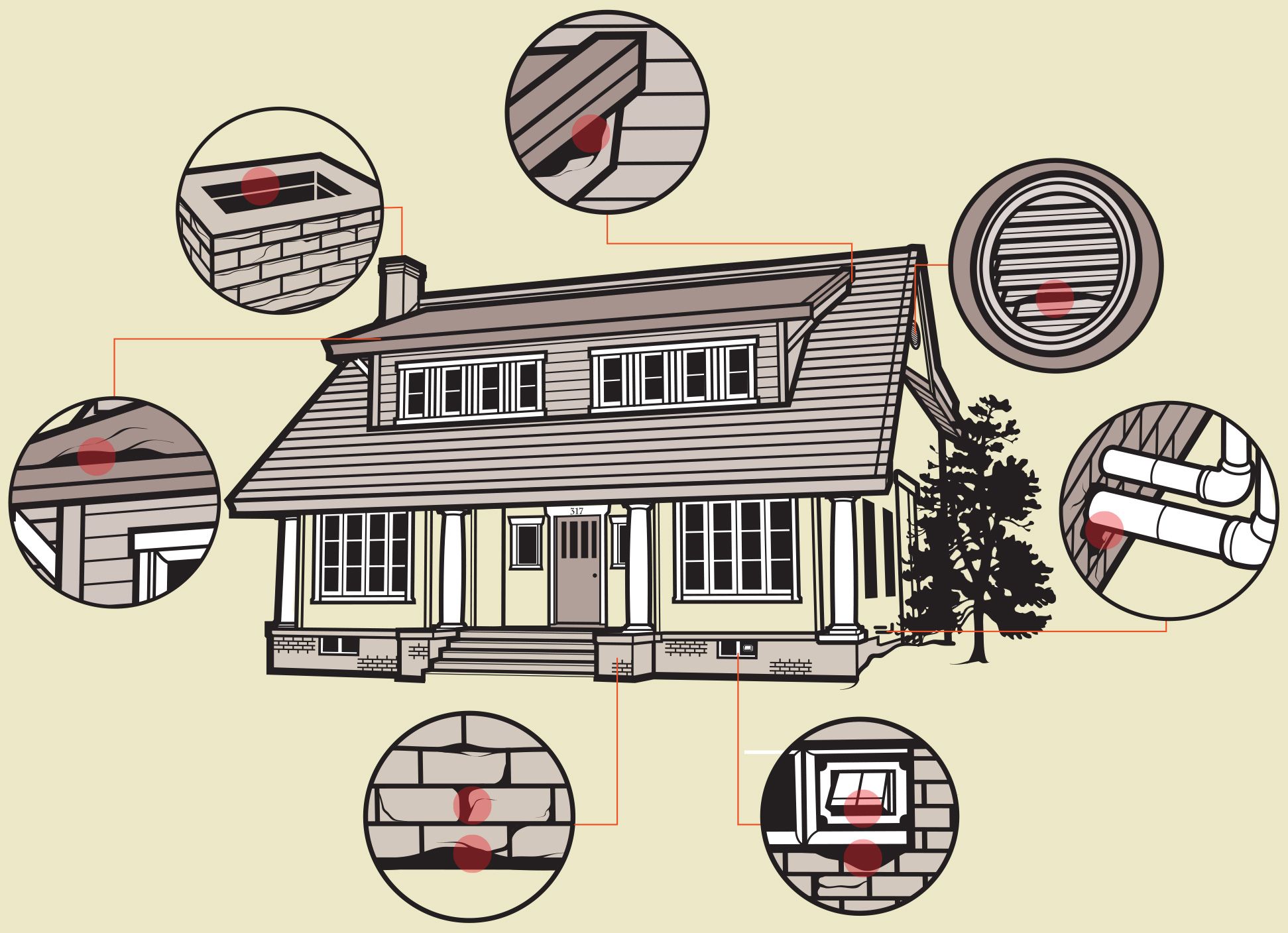
Unwanted animal guests can turn your home into a zoo, causing damage and posing health risks. Mice, raccoons, bats—many creatures see your house as shelter and a food source. Keeping out pests requires attention, prevention, and sometimes professional treatment. This guide covers common entry points, identifies frequent intruders, and provides strategies to keep wildlife outside where it belongs.
Common Home-Invading Animals
Many creatures may attempt to infiltrate your home, but these are the most common.
Mice
Mice can squeeze through openings as small as one-quarter-inch in diameter and are attracted to food sources and warm shelter. They leave droppings and chew through food packaging. You can often hear them scratching and squeaking in the walls.
To prevent mice, seal entry points and store food in airtight containers. Place mouse traps along walls and in areas where you suspect activity.
Rats
Rats need larger openings, about three-quarters of an inch in diameter, to get into your home. They’re stubborn invaders and can cause severe damage. Look for greasy smudge marks on baseboards and larger droppings, and listen for gnawing sounds at night.
Eliminating outdoor food and water sources, including bird feeders and pet dishes, can prevent rat infestations. Use hardware cloth or steel flashing to cover potential entry points.
Squirrels
Squirrels are agile climbers that can jump up to 10 feet. They often enter your home through roofs and attics. If you hear scampering noises in the attic or walls, see chewed insulation, or find piles of nuts or acorns in hidden spaces, you likely have squirrels inside.
To keep them away, trim trees away from your house and keep your roof and exterior trim in good condition. Use hardware cloth to cover potential entry points temporarily until permanent repairs are made.
Bats
Bats can squeeze through tiny openings and often roost in attics. To remove them, observe them at dusk to find their entry points, use one-way exclusion devices, and seal holes once you get them out. Many bat species are protected, so consult a professional for safe, legal removal. A pro can also help install a bat flap, which will let bats crawl out but block their way back in.
Birds
Birds often build nests in dryer vents or other home openings. Install vent covers to prevent future nesting. Once nesting season is over, remove the nests and repair damage to vents. Some bird species are protected by law as well, so reach out to a professional for help.
Raccoons
Raccoons may use your chimney as a den. Use bright lights and loud noises to encourage them to leave or bait them out. Once they’re gone, close any holes and install a chimney cap. Never try to smoke them out, as this can be dangerous for both you and them. Professional help is often necessary for safe raccoon removal.
Skunks
Skunks may burrow under porches or decks. Bright lights and ammonia-soaked rags can deter them, as can removing potential food sources from your yard. Install sturdy fencing around your porch base to keep them from coming in. Always handle skunk situations carefully to avoid getting sprayed, and call a professional for help if needed.
Signs of Animal Infestation
Recognizing infestation signs and addressing pests early can help prevent damage and avoid health risks.
Visual Clues
Inspect infrequently used areas of your home, such as attics, basements, and crawl spaces for these signs:
- Droppings or urine stains
- Chew marks on wood, wires, or food packaging
- Nests made from shredded materials
- Tracks in dusty areas
Typical Sounds
You may hear these noises, especially at night when many pests are most active:
- Scratching or scurrying in walls or ceilings
- Chirping or squeaking noises
- Thumping sounds in the attic
Unexplained Odors
Unusual odors can indicate animal presence. Track any bad smells to find and address problem areas, such as the following:
- Rotting smells that may indicate a dead animal
- Musky smells from rodent urine
- Ammonia-like odors from piles of droppings
Common Entry Points for Animals
Find and cut off entry points to prevent pests from coming in. Be sure to repair any damage or openings to cut off access as well.

Roofs and Attics
Your roof and attic are prime targets for animal entry. Squirrels and raccoons can easily climb to these areas and get into gaps in your roof, under overhanging shingles, in open chimneys, and through damaged or missing soffit vents.
Ground-Level Openings
Many animals enter homes at ground level through small openings such as cracks in the foundation and gaps around doors and windows. Some may create their own entrances through rotted wood siding or trim. To keep pests out, seal these openings with mortar, steel wool, or hardware cloth.
Utility Lines
Pipes, cables, and other utility lines create perfect highways for animals to enter your home. Use caulk, expandable foam, or metal flashing to seal gaps around electrical and plumbing lines, unsealed dryer vents, and loose or damaged vents in your crawl space.
Animals in Our Home: Preventive Measures
Taking proactive steps to animal-proof your home is key to preventing infestations. In addition to sealing entry points, below are some strategies to keep wildlife at bay.
Landscaping and Yard Maintenance
Smart landscaping can help keep plant-eating animals at bay and deter them from coming closer to your home. Trim tree branches away from your roof and keep bushes and shrubs well-pruned. Remove fallen nuts and fruits promptly to eliminate a food source, and store firewood away from the house.
Food Storage and Waste Management
Eliminate food sources that might attract animals by storing your and your pet’s food in airtight containers and using secure, animal-proof trash cans. Clean up your outdoor eating areas as soon as you’re done. Make sure to place any birdfeeders far from the house or remove them if they continue to cause issues.
DIY vs. Professional Pest Removal
Know when to tackle animal removal yourself and when to call in experts to get the job done safely, legally, and effectively.
When To DIY
You should be able to handle minor issues, such as mice or small birds, on your own. Set traps for mice and rats, install exclusion devices for bats, and remove bird nests when legal to do so. Always prioritize safety and follow local regulations when dealing with wildlife.
When To Call the Experts
Some situations require professional intervention, such as large infestations, protected species, rabid animals, situations where you don’t know what the animal is, or if you’re not sure you can remove the pest safely.
Diseases Transmitted by Animals
Many pests carry diseases transmissible to humans. Always use protective gear when cleaning up after an infestation, and seek medical attention if you suspect exposure. Common health issues diseased animals can cause include the following:
- Hantavirus from rodents
- Rabies from bats, raccoons, and skunks
- Leptospirosis from rat urine
- Histoplasmosis from bird droppings
Structural Damage Risks That Animals Pose
Animals can damage your property’s interior and exterior. They chew electrical wires, posing fire hazards and damaging insulation, which can reduce your home’s energy efficiency. They also cause water damage when they borrow into and block vents and gutters, and they gnaw and chew at the internal structure of your home. Regularly inspect and fix any infestations to avoid expensive home repairs.
Check out some of our best pest control resources to keep rodents out of your home:
